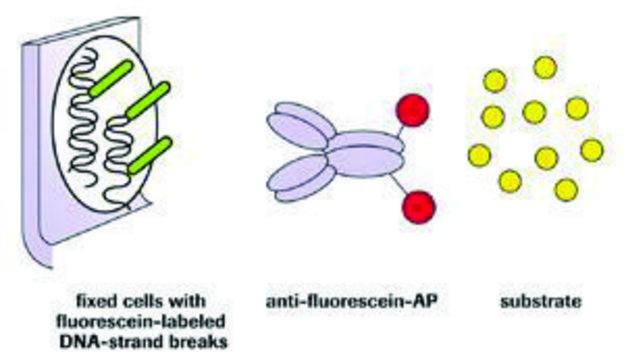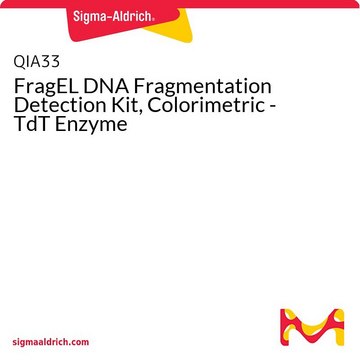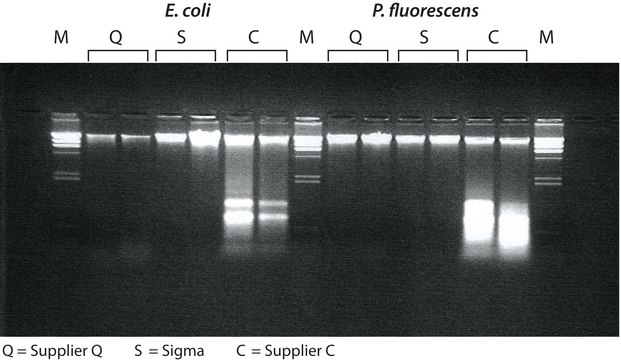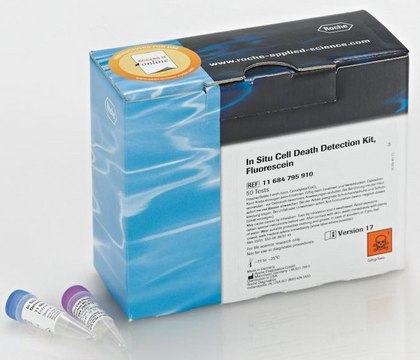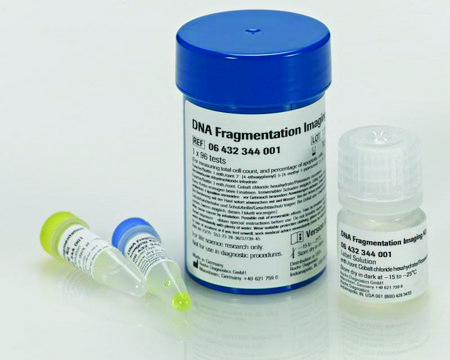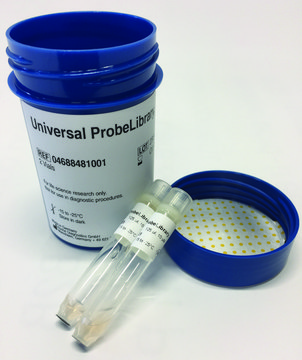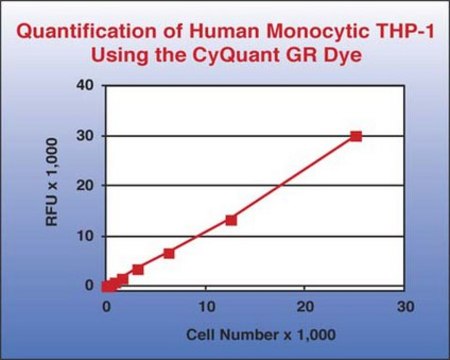Recommended Products
species reactivity
pig, human, rat, horse, hamster, mouse, guinea pig, rabbit, canine, nonhuman primates
manufacturer/tradename
Chemicon®
technique(s)
ELISA: suitable
General description
This procedure is based on the selective denaturation of DNA in apoptotic cells by formamide, and detection of denatured DNA with monoclonal antibody to single-stranded DNA (ssDNA). Formamide is a gentle agent that denatures DNA in apoptotic cells, but not in necrotic cells or in the cells with DNA breaks in the absence of apoptosis (Frankfurt & Krishan 2001). The sensitivity of DNA in apoptotic cells to formamide is not related to DNA breaks, but rather reflects changes in chromatin associated with apoptosis, such as chromatin condensation and digestion of proteins stabilizing DNA. The assay includes attachment of cells to 96-well plates, treatment of attached cells with formamide, and staining of ssDNA in apoptotic cells with a mixture of primary antibody and peroxidase-labeled secondary antibody. The protocol based on the one-step detection of ssDNA with antibody mixture has higher sensitivity and lower number of steps than standard two-step immunostaining (Frankfurt & Krishan 2001). This mixture is included in the kit in a ready to use form.
Application:
The CHEMICON ssDNA Apoptosis ELISA Kit is a convenient, sensitive method for early detection of apoptosis. The assay can be performed in two formats:
1. Cells are grown, treated with apoptosis inducing agents, stained and analyzed in the same microtiter plate. This assay is suitable for high throughput screening when induction of apoptosis is used as the endpoint of drug activity.
2. Cell suspensions obtained from cultures or tissues are transferred into a microtiter plate for staining and analysis. For this assay, cells could be fixed with methanol and stored before transfer into plates. Alternatively, fixation could be performed in microtiter plates after transfer of non-fixed cells.
Total assay time is 3-4 hours, which includes fixation and staining. Only one washing step is required.
The ssDNA Apoptosis ELISA is for research use only. Not for use in diagnostic or therapeutic procedures.
Application:
The CHEMICON ssDNA Apoptosis ELISA Kit is a convenient, sensitive method for early detection of apoptosis. The assay can be performed in two formats:
1. Cells are grown, treated with apoptosis inducing agents, stained and analyzed in the same microtiter plate. This assay is suitable for high throughput screening when induction of apoptosis is used as the endpoint of drug activity.
2. Cell suspensions obtained from cultures or tissues are transferred into a microtiter plate for staining and analysis. For this assay, cells could be fixed with methanol and stored before transfer into plates. Alternatively, fixation could be performed in microtiter plates after transfer of non-fixed cells.
Total assay time is 3-4 hours, which includes fixation and staining. Only one washing step is required.
The ssDNA Apoptosis ELISA is for research use only. Not for use in diagnostic or therapeutic procedures.
Application
Positive Control
To use the ssDNA positive control included in this kit:
1. Add 100 μL of ssDNA Positive Control solution per well and dry plate by floating in a 37ºC waterbath or in a 37ºC incubator or culture hood (fan on) with lid off, overnight or until very dry. WELLS MUST BE THROUGHLY DRY for ssDNA to adhere to the wells.
2. Rinse wells with PBS before use. Plate can be stored dry, covered until ready to use.
3. Proceed to step 8 of Assay Instructions below if positive control is done on a separate plate. If performing entire assay on one plate, proceed to sample preparation below, ignoring wells used for positive control UNTIL step 8.
Note: Absorbance reading between 1.5 and 2.8 indicates good assay sensitivity; lower values will still work, however it may indicate that some of the ssDNA has come off the plate. One can reapply ssDNA standard again, if necessary.
To use the ssDNA positive control included in this kit:
1. Add 100 μL of ssDNA Positive Control solution per well and dry plate by floating in a 37ºC waterbath or in a 37ºC incubator or culture hood (fan on) with lid off, overnight or until very dry. WELLS MUST BE THROUGHLY DRY for ssDNA to adhere to the wells.
2. Rinse wells with PBS before use. Plate can be stored dry, covered until ready to use.
3. Proceed to step 8 of Assay Instructions below if positive control is done on a separate plate. If performing entire assay on one plate, proceed to sample preparation below, ignoring wells used for positive control UNTIL step 8.
Note: Absorbance reading between 1.5 and 2.8 indicates good assay sensitivity; lower values will still work, however it may indicate that some of the ssDNA has come off the plate. One can reapply ssDNA standard again, if necessary.
Research Category
Apoptosis & Cancer
Apoptosis & Cancer
Used to detect/quantify: ssDNA
Packaging
96 wells
Components
Antibody Mixture, Primary monoclonal to ssDNA and HRP-labeled goat anti-mouse IgM (Part No. 71278a): One 10 mL bottle, premixed (Ready to Use).
Formamide (Part No. 71278b): One 5 mL bottle (Ready to Use).
Single-stranded DNA Positive Control (Part No. 71278c): One 2 mL vial at 0.3 μg/mL.
Wash Buffer Concentrate (Part No. 90160): One 10 mL (10X) bottle of Concentrate.
ABTS Solution (Part No. 90161): One 12 mL bottle of a Ready to Use solution of 2,2′-AZINO-bis [3-ethylbenziazoline-6-sulfonic acid] in a proprietary buffer with enhancer.
Stop Solution (Part No. 90162): One 12 mL bottle of an HCl solution (Ready to Use).
Formamide (Part No. 71278b): One 5 mL bottle (Ready to Use).
Single-stranded DNA Positive Control (Part No. 71278c): One 2 mL vial at 0.3 μg/mL.
Wash Buffer Concentrate (Part No. 90160): One 10 mL (10X) bottle of Concentrate.
ABTS Solution (Part No. 90161): One 12 mL bottle of a Ready to Use solution of 2,2′-AZINO-bis [3-ethylbenziazoline-6-sulfonic acid] in a proprietary buffer with enhancer.
Stop Solution (Part No. 90162): One 12 mL bottle of an HCl solution (Ready to Use).
Storage and Stability
Store kit materials at -20°C. Once the kit is opened, Antibody Mixture and ssDNA Positive Control should be thawed on ice, aliquoted and stored at -20ºC. Formamide, Wash Buffer, ABTS Solution and Stop Solution can be thawed and stored at 4°C.
Legal Information
CHEMICON is a registered trademark of Merck KGaA, Darmstadt, Germany
Disclaimer
Unless otherwise stated in our catalog or other company documentation accompanying the product(s), our products are intended for research use only and are not to be used for any other purpose, which includes but is not limited to, unauthorized commercial uses, in vitro diagnostic uses, ex vivo or in vivo therapeutic uses or any type of consumption or application to humans or animals.
Regulatory Information
新产品
Certificates of Analysis (COA)
Search for Certificates of Analysis (COA) by entering the products Lot/Batch Number. Lot and Batch Numbers can be found on a product’s label following the words ‘Lot’ or ‘Batch’.
Already Own This Product?
Find documentation for the products that you have recently purchased in the Document Library.
Tadeusz-Wojciech Lapinski et al.
World journal of gastroenterology, 11(39), 6130-6133 (2005-11-08)
To evaluate the activity of apoptosis in liver tissue and explore its possible association with hepatic necroinflammation and fibrosis as well as serum hepatitis C virus (HCV) load. The studied population included 50 chronic hepatitis C patients (20 women and
Jozaa Z ALTamimi et al.
Saudi pharmaceutical journal : SPJ : the official publication of the Saudi Pharmaceutical Society, 29(1), 27-42 (2021-02-20)
This study examined if the Fisetin against streptozotocin-induced diabetic cardiomyopathy (DC) in rats involves regulating cardiac metabolism and suppressing protein kinase R (PKR). Male rats were divided (12/groups) as control (non-diabetic), control + Fisetin, T1DM, and T1DM + Fisetin. Fisetin was administered orally at
Brian Bauereis et al.
Neuroscience letters, 488(1), 11-16 (2010-11-09)
Previous studies in Parkinson's disease (PD) models suggest that early events along the path to neurodegeneration involve activation of the ubiquitin-proteasome system (UPS), endoplasmic reticulum-associated degradation (ERAD), and the unfolded protein response (UPR) pathways, in both the sporadic and familial
Wen-Bin Zhu et al.
Oncology letters, 15(1), 433-440 (2018-01-30)
Tangeretin, a natural polymethoxyflavone present in the peel of citrus fruits is known to exhibit anticancer properties against a variety of carcinomas. Previous experimental evidence suggests that lifestyle and dietary habits affect the risk of prostate cancer to a certain
Cheng-Fang Yang et al.
International journal of molecular medicine, 41(4), 2306-2316 (2018-01-18)
The aim of the present study was to assess the molecular mechanism of ethanol‑induced oxidative stress‑mediated apoptosis in L‑02 liver cells in order to elucidate novel pathways associated with alcoholic liver disease. L‑02 cells were treated with 400 mM ethanol with
Our team of scientists has experience in all areas of research including Life Science, Material Science, Chemical Synthesis, Chromatography, Analytical and many others.
Contact Technical Service

